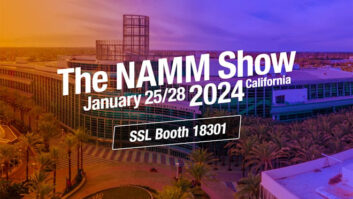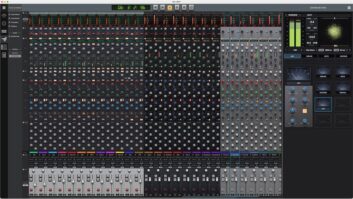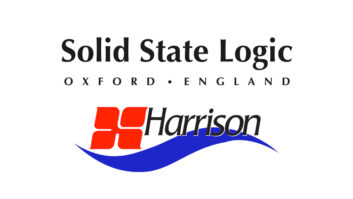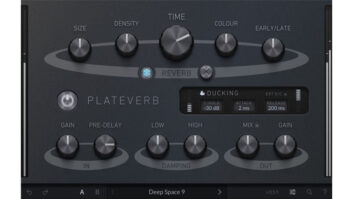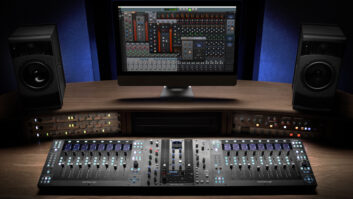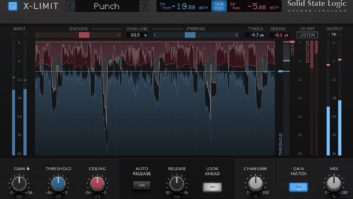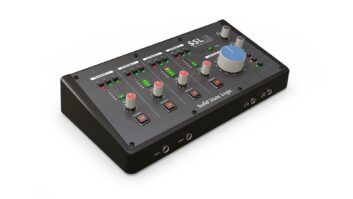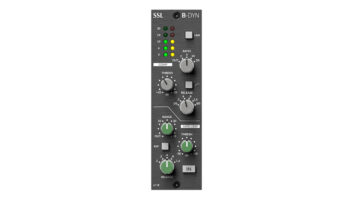In the 1965 article entitled “Cramming More Components onto Integrated Circuits,” Intel co-founder Gordon E. Moore observed that the number of transistors that can be inexpensively placed on an integrated circuit has doubled approximately every two years, and predicted that this exponential trend is likely to continue. This prescient analysis became known, quite famously, as Moore’s Law.

I am not invoking Moore in reference to the small size or processing power of the Solid State Logic Duende Mini, but instead to the Mini’s ever-expanding primary market: laptop-based, native digital audio workstation users. Moore’s Law, loosely applied, suggests that as laptop contemporary performance continues to increase, more DAW users will be attracted to the potential benefits inherent to going mobile. Lightweight, DSP add-ons such as the Duende Mini significantly increase the allure and, of course, power of portable production setups.
Features
The Duende Mini ($995) is a 1RU FireWire-based plug-in processor. Its sleek and lightweight, brushed-aluminum chassis sports a spartan set of features comprised of a front-panel power button; parallel 6-pin FireWire 400 connectors and a 12V DC power input jack. Included with the Mini package is a FireWire cable, adhesive rubber feet, and a universal power supply with a variety of AC outlet adapters. The Mini can also be powered by the FireWire bus over 1394A (6-pin) connections.
Minimum system requirements for Windows PCs include: Intel Pentium IV 1GHz or equivalent; XP SP2 (32-bit Vista is also supported); and 80MB of free hard disk space. For Macs: PowerPC G4/G5 or Intel 1GHz; OS X (Version 10.4.8 or higher); and 60MB hard-disk space. Both platforms need 512MB RAM though 1GB is recommended.
VST and RTAS versions of the EQ and Dynamics Channel Strip plug-in are provided for Windows, and VST, AU and RTAS versions are provided in a universal binary format for both Intel and PowerPC Macs. A selection of optional plug-ins, including the famous SSL Bus Compressor, the Drumstrip drum processor, X-Comp and X-EQ are also available from SSL for $399- $599 each.
In Use
Installation of the Mini on my laptop (a 2 GHz dual-processor Dell with 2 GB of RAM, XP Pro and Steinberg Nuendo 4) was quick and painless. The latest software version offered online is a full install package so there’s no need to bother with the boxed CD, and the installer auto-upgrades the firmware if required – nicely done.
I was a bit surprised when I found that, unlike competing DSP systems, the Duende Mini includes just one plug-in. That plug-in, however, is the quite substantial EQ and Dynamics Channel Strip – outfitted with trademark SSL filtering, EQ, compressor/limiter, and expander/gate sections. The Mini can power up to 16 mono instances of this plug-in at 44.1/48 kHz or eight at 88.2/96 kHz. In a bit of brilliant strategic planning, the Mini can be field-upgraded to 32 channels ($399) via a software authorization process that simply unlocks the power of additional, pre-installed SHARC chips.
It wasn’t long after loading up 16 channels of the strip into the Nuendo mixer that SSL’s intentions with its singular approach became apparent. The Nuendo mixer instantly took on the appearance and – as subsequent knob twiddling revealed – much of the sonic signature of a 9000. The latter, as it turned out, is not surprising given that the Mini’s processing engine and analog modeling is derived from the C200 digital consoles, which, in turn, emulate the EQ and dynamics sections of SSL’s classic “SuperAnalogue” XL 9000 J and K consoles.
The Channel Strip plug-in is comprised of sweepable high- and low- pass filters, a four-band EQ section (two parametric mid-bands, two bell/shelf switchable semi-parametric outer bands and E/G curves), and dynamics section that includes the classic SSL channel compressor/limiter and gate/expander. Input and output meters and level knobs are provided, as are gain-reduction meters for both dynamic processors, and a phase-invert button.
The Channel Strip sections are nearly identical* to those found on the SSL Duality console/controller I reviewed in April 2007, and in the SSL X-Rack modular system reviewed this past December and January; both reviews are available online at www.proaudioreview.com and on my website. Each control and unique feature – including the dual E-/G-series filter response curves, EQ-to-Dynamics side chaining, the compressor’s hard-knee peak sensing mode, auto-makeup gain and more – is covered in detail and in-use, so please take a look.
*The only actual feature differences I found were that the plug-in EQ is G-Series mode by default (switchable to E), the sweepable high-pass maxes out at 500 Hz instead of 600 Hz, and the plug-in benefits from the ability to display EQ/Dynamics signal flow and side chain mode graphically.
All in all, the emulations of the XL9000 K (via the C200) in the Channel Strip are a joy to behold outside their original environments and, more to the point, in my DAW. And I definitely get the “virtual console through channel strips” concept. What I don’t get is why the individual processing sections of the Channel Strip – EQ, Dynamics and Filters – couldn’t be provided as discrete plug-ins as is done in most other systems. This, of course, would allow more economical use of available processing (and encourage interesting combos with other plug-in makes), and reduce the temptation to use the whole channel strip when only the EQ was needed – you know, the “because it was there” and “couldn’t let them go to waste” rationalizations that lead to overuse.
Summary
After many weeks of using the Solid State Logic Duende Mini and Channel Strip plug-in in a number of ways and in varying amounts and on a variety of project types, I came to two overall conclusions: 1. The SSL Duende Mini running the EQ and Dynamics Channel Strip plug-in does a super-impressive job of capturing the sound of its SuperAnalogue XL9000 K counterpart and, 2. All things in moderation.
Having the mixer in Nuendo look, behave and sound like an SSL C200 has been a joy — a real blast, to own the truth – but I found that it’s also easy to get carried away with such a fun and singular processing tool that an overly aggressive buildup can occur. Mixing up the SSLs with my old friends from the UAD and PowerCore platforms not only broadened the overall sonic scene but also served to spotlight in the mix the tracks that benefited most from the familiar SSL sounds-like-a-record signature sound.
Having the Duende Mini in my system and the many Channel Strips a mouse-click away feels like owning a piece of rock – highly recommended.
Product Points
Plus
- Spot-on analog emulations
- Minuscule (6.5″ x 6.5″), light (3 lbs) and bus-powered
- 2 pre-installed DSPs can be software-activated for 32 channels of processing
Minus
- Only includes one plug-in
- Individual Channel Strip sections not broken into discrete plug-ins for DSP-economical use
Score
It’s no substitute for the real SuperAnalogue stuff, but it’s super-close!
Fast Facts
Applications: Studio
Key Features: DSP-powered plug-in processor; FireWire 400 interface; bus-powered with 6-pin 1394A equipped computers; universal power supply with worldwide AC socket adapters; 16 mono channels of plug-ins at 44.1/48 kHz, 8 at 88.2/96 kHz; includes the EQ and Dynamics Channel Strip plug-in.
Price
$995
Contact
Solid State Logic | www.solidstatelogic.com
